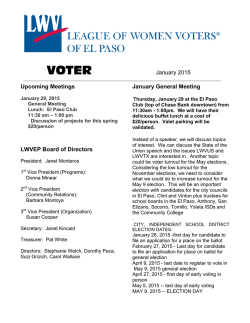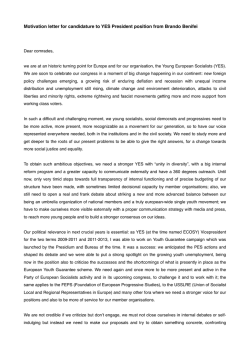
Family Policy in the 2015 Election: Back to the Future
29 Prime Minister Brian Mulroney at the wheel of his campaign bus in 1988. When the election writ dropped, his government’s $6.4 universal child care bill died on the Order Paper in the Senate because of a Liberal filibuster over the free trade bill. In today’s terms, the child care package would have been worth twice that amount. Montreal Gazette archives. Family Policy in the 2015 Election: Back to the Future Geoff Norquay The broad outlines of the current debate over the federal government’s role in child care support date back to the 1980s, when the influx of women into the full-time work force of the previous two decades put pressure on Ottawa to formulate a national child care policy. As former Prime Minister Brian Mulroney tells his former social policy adviser Geoff Norquay, his government’s solution was a compromise that should have worked. The same stakeholders who made that impossible will be highly vocal in the upcoming election campaign. A s we look ahead to the issues that will dominate the 2015 fed eral election, it’s clear that family policy will be high up the list. The reason is obvious: the head-to-head confrontation between NDP Leader Thomas Mulcair’s national child care proposal and Stephen Harper’s family tax cut package, both revealed last fall. In the past 30 years there have been three major attempts to hit the reset button on family policy in Canada. First, there was the Mulroney government’s child care January/February 2015 30 strategy of 1987-88, followed by the Martin government’s child care plan of 2005. The choices on offer from Mulcair and the Prime Minister today present another two conflicting visions from which to choose. Looking back over the history of family policy, it is instructive to consider what has changed and what has stayed the same in this long-running debate. The Martin and Mulcair proposals both narrow the idea of family policy to child care. The Mulcair/Harper proposals represent the two divided sides of family policy, child care versus broader tax support for families with children. Only the Mulroney proposals actually unified the child care/tax support divide into a comprehensive and balanced family policy. The Mulroney plan was very much a product of the social changes sweeping the country in that period. Between 1961 and 1980, the percentage of married women in the paid labour force in Canada jumped from 22 per cent to 50 per cent, and these swelling ranks put huge pressure on the country’s child care resources. By the 1980s, child care was funded through the social services provisions of the Canada Assistance Plan, the joint federal-provincial cost-sharing arrangement created in 1966. P rovinces had taken starkly dif ferent approaches to delivering child care. Some had taken advantage of federal cost-sharing and pursued the public provision route, while others had opted to develop their services through the licensing of commercial, for-profit child care centres. Most provinces had varying mixes of the two approaches. In addition, provinces also ranged significantly in their fiscal capacities and many were wary of a huge new spending commitment. They wanted to see stronger federal leadership and greater assistance with growing child care costs, but they were concerned about their ability to provide the matching funds required by the Canada Assistance Plan. Policy The Mulcair/Harper proposals represent the two divided sides of family policy, child care versus broader tax support for families with children. Only the Mulroney proposals actually unified the child care/tax support divide into a comprehensive and balanced family policy. Parental views across the country diverged as well. Among those families where only one spouse was working outside the home, there was strong support for increased tax breaks for stay-at-home parents. They argued they should not be “disentitled” because one spouse chose to stay home and not make use of formal child care. Finally there was the child care advocacy community, whose members had one objective and one objective alone: universal, fullyaccessible, publicly-funded and publicly-run institutional child care, or nothing at all. And finally there was the child care advocacy community, whose members had one objective and one objective alone: universal, fully-accessible, publicly-funded and publicly-run institutional child care, or nothing at all. For them, any money spent via the tax system to recognize the costs of families raising their children at home, or to support the care of children in commercial centres, was an unacceptable diversion of funds away from creating the public and universal child care system they demanded. If the Mulroney child care plan was a product of its time and shifting demographic realities, it was also a delicately balanced compromise designed to bow towards a complex set of constituencies at the same time. No side was going to get everything it wanted, but there were a lot of positives to go around. Introduced in December of 1987 with a promise to create 200,000 new child care spaces across the country, the National Strategy on Child Care had three key components: • T he Canada Assistance Plan would be amended to expand cost-sharing for the operating costs of both non-profit and commercial child care services, and to provide expanded cost-sharing for operating costs as well as enriched support (75 per cent federal/25 per cent provincial) for capital costs, but only for the public, not-for-profit sector. • A seven-year Initiatives Fund of $100 million would fund delivery innovations such as “nonprofit community-based child care services.” • T ax assistance to families with young children would be increased by raising the child care deduction in the Income Tax Act, and refundable child tax credits would be introduced for parents caring for their children at home. The Mulroney family package represented a federal commitment of $6.4 billion over seven years, or $11.2 billion in today’s dollars. This was a huge financial commitment for a government at that point running a $30 billion annual deficit and facing a rising national debt. All in, the Mulroney family package represented a federal commitment of $6.4 billion over seven years, or 31 $11.2 billion in today’s dollars. This was a huge financial commitment for a government at that point running a $30 billion annual deficit and facing a rising national debt, even though the deficit was falling year over year, government spending had been restrained, and the rate of increase in the debt had been significantly reduced. Looking back today, former Prime Minister Mulroney points out that he had every confidence that a growing national economy, buttressed by the recently signed 1987 Canada-US Free Trade Agreement, would provide the funds necessary to support the investment. “I felt,” he says today, “that the positive impacts of free trade, combined with the GST reform we were planning, were going to generate significant economic wealth and job creation for the country. So we could sustain this program.” Mulroney had another reason for putting his faith in child care and it was a political one. In a meeting with his pollster Allan Gregg that fall, he recalls that Gregg had expressed his “worst fears that the focus on the mercantile aspects of free trade threatened to cast the Progressive Conservatives as little more than a bunch of black-hearted accountants. So I went with the child care package because it met an obvious social need and to counteract that argument politically.” The first part of the strategy, namely the increase in the child care expense deduction and the refundable child care tax credit, was brought in for the 1998 tax year. The balance of the package, the federal-provincial funding changes, including the enhanced funding for both capital and operating cost, was all contained in Bill C-144. T he institutional child care lob by, backed by the Liberals and NDP, strenuously attacked the income tax aspects of the program as a cynical attempt by the government to curry favour with conservative stay-at-home parents, many With the 1988 federal election fast approaching, time ran out on the legislation and having already passed in the House, it languished in the Senate. There, the Liberals, led by Senator Allan J. MacEachen, effectively killed the bill by refusing to pass it before the election was called. of whom were likely to vote PC. The advocates and the opposition made common cause and demanded that every penny of the promised federal funds be devoted to the institutional bricks and mortar approach. world outlook was bleak, and that a recession was on the way,” he recalls. “But not to worry, they told me, because Canada would have a ‘soft landing.’ As I recall it, the landing was anything but soft.” Throughout this period, PMO made several attempts to bring around the opponents of the bill. Among them was a Langevin Block meeting with the child care advocates who continued to demand that the family-friendly tax measures be withdrawn and that all of the federal investment be directed towards publicly-sponsored child care spaces. At one point in the meeting, PMO colleague L. Ian MacDonald asked the advocates, “What if we miss this window and the legislation dies on the Order Paper when the election is called? It may never come back.” The response? “Oh, that would never happen.” As we approach the upcoming debate over family policy in the 2015 federal election, it is clear that while the social landscape has seen some change, many of the arguments have stayed the same. The proportion of two-earner families has grown since the late 1980s, and many families still struggle with the costs of child care. The child care system itself remains mixed, with publicly-run, private for- profit providers, parental cooperatives and family home day care options all on offer. Quebec’s $7.50 per day public system has been a major innovation, but it is hugely costly and serious questions are being raised about its financial sustainability by Premier Philippe Couillard’s Quebec Liberal government, which is introducing a sliding scale of fees according to parents’ ability to pay. Well, actually that’s exactly what did happen. With the 1988 federal election fast approaching, time ran out on the legislation and having already passed in the House, it languished in the Senate. There, the Liberals, led by Senator Allan J. MacEachen, effectively killed the bill by refusing to pass it before the election was called. D id the child care initiative re turn after the election, (the one, by the way, in which the free trade issue dominated all discussion)? It did not and for a variety of reasons. Issues changed, new challenges and priorities emerged, the government moved on to other questions. Also, as former PM Mulroney recalls, the economy unexpectedly turned for the worse. “The Department of Finance paid me a visit that fall after the election to warn that the economic numbers had changed, the The modern debate over family policy began in the 2006 federal election campaign, when then prime minister Paul Martin committed $5 billion over five years to create 250,000 new child care spaces by 2009. By 2006, most of the provinces had signed on to the program and it was in the early stages of implementation. Conservative opposition leader Harper made his family policy alternative a key part of the 2006 campaign—a promise to roll-back the Liberal program and to provide instead a $100 per month universal child care benefit. Once in office, Harper collapsed the Liberal program and brought in the tax break. Interestingly, the Martin child care January/February 2015 32 program was taken down by the Harper Conservatives with nary a ripple of public outcry, suggesting perhaps that there was not nearly as much support for the Liberal plan as they had assumed. In addition, provinces were still wary of federal programs creating public demands for matching provincial commitments, so they did not complain loudly at the demise of the Liberal program. Mulcair’s return to a national child care plan is in the grand tradition of such approaches; the question is whether it is still relevant, and how families with children will assess the two in the upcoming election campaign. I n many ways, then, the 2006 cam paign re-set the terms of the fam ily policy debate in Canada. The muted public and provincial reaction to Harper’s abolition of the Liberal child care plan gave him free reign to pursue the tax support alternative to the exclusion of the child care approach. In that light, Mulcair’s return to a national child care plan is in the grand tradition of such approaches; the question is whether it is still relevant, and how families with children will assess the two in the upcoming election campaign. Mulcair has promised an initial fouryear plan to fund 370,000 new child care spaces at an annual federal cost of $1.9 billion to be transferred to the provinces, on a 60/40 cost-sharing basis with the provinces. After eight years, the federal share would reach $5 billion annually. Harper has countered by building on the family tax breaks he brought in back in 2006, with three new initiatives: • A tax credit with a cap of $2,000, calculated by allowing the higher- Policy An interesting aspect of the debate is sure to be the question of who gets what benefits under the two opposing schemes, and how fair is the distribution of those benefits? earning spouse in a couple with children to transfer up to $50,000 of income to the lower-earning spouse, also known as “income splitting”; • A n increase to the Universal Child Care Benefit, from $100 to $160 a month for each child under the age of six, plus a new $60-amonth payment for each child between six and 17; and • A higher income tax deduction for child care expenses, to $8,000 a year from $7,000. And an increase in the tax deduction for child care expenses for children with disabilities from $10,000 to $11,000. Given that most users of child care are double-income families with small children, it stands to reason that more of the financial benefits of public child care are delivered to middle income family units than to poor and single parent families. S o, the lines of debate over family policy in Campaign 2015 have already been drawn. It will be the traditional bricks and mortar child care approach versus ensuring that “parents have choice in the type of child care that works best for their family,” as the PM’s spokesperson recently told the Globe and Mail. At this point, the Liberals have been largely absent from the family and child care debate other than leader Justin Trudeau opposing income splitting as a tax break for the rich— affluent parents such as Harper and himself. An interesting aspect of the debate is sure to be the question of who gets what benefits under the two opposing schemes, and how fair is the distribution of those benefits? Mulcair will go hard against the tax progressivity of the income splitting approach, and Harper will counter that if income splitting is fair and works well for seniors, it can hardly mean the end of the world for tax fairness if it is applied to one income earner families with children up to a $2,000 cap. Mulcair will argue that the Harper approach delivers far too many financial benefits to middle and upper income-earning families, but will likely say nothing about the redistributive impacts of his child care plan. Given that most users of child care are double-income families with small children, it stands to reason that more of the financial benefits of public child care are delivered to middle income family units than to poor and single parent families. Ladies and gentlemen, start your engines. Contributing Writer Geoff Norquay, a principal of the Earnscliffe Strategy Group, was senior social policy adviser to Prime Minister Mulroney from 1984-89. [email protected]
© Copyright 2026









